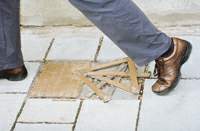A discussion with Ladislav Snopko
Editorial board
There has been nothing more distinctive in cities for thousands of years than stone pavement. Bratislava is also rich in history, and stone pavement is a fundamental part of the historical core, which has recently and finally started to be renovated. Along with older, but newly set stones and new pavement, there are also small stone or bronze art works in the centre, randomly arranged. These were only created lately, and spread in the centre from Bratislava’s Town Gallery. It was this gallery that came up with the idea of reviving an older project, originally initiated by Ladislav Snopko in the 1980s. Invited artists of several generations and nationalities created small works directly in the stones, which took on a life of their own in a public place. Therefore, a new gallery has arisen in Bratislava which you do not have to visit since you can encounter it directly on the street. We asked the project’s initiator, Mr. Ladislav Snopko, how it was created. “It all started in the 1980s. As an archaeologist I was then working on a research project excavating an antique archaeological location known as Gerulata in Rusovce. This research was unique in Slovakia (and the then Czechoslovakia), and it was certainly extremely interesting. Gerulata, as the only location of antiquity from the Roman Empire situated on the territory, was part of the fortification of the Roman border, an area which reached up as far as the River Danube. Gerulata also featured a stone paved entryway. I was responsible for cleaning and touching the remains of this tiled floor – probably from the end of the third century. I think it was this touch that became some kind of magical contact with the past. Apart from the past, the stone pavement hid another matter – the phenomenon of a crossroads going east-west in the direction of the Danube, and north-south (for example the Amber Way). From a geographical point of view, central Europe is a typical crossroad. Many cultures crossed here and in Slovakia, the most eastern part of West Christian confession territory, many ethnicities intermixed. Every one of them left their mark here, and therefore culture has its individual dimension. In the 1980s, the natural dimension of this territory has no longer been functioning. However, it all remained in the stones. The joy from the experience of an archaeologist I joined with an experience of totalitarian society inhabitant who devoted himself to free projects, mainly artistic, that wanted to disturb this totality. Then I came up with an idea that could at least conceptually show that central Europe and Bratislava are different. The project for the participants was that the artist (painter, musician, architect) must create their own contemporary interpretation of a stone pavement on the basis of an archaeological fragment. They could not destroy or reconstruct the fragment with their interpretation. The works were presented at a huge event in Bratislava. In 2000, the director of the Bratislava’s Town Gallery asked me if we could revive this project and thus make the centre of Bratislava more attractive. The tiles are now in place. There is only one of the original works, but we are considering placing more of them. Since last year there has been a new initiative, and the gallery’s director has been talking to our partner towns of Graz and Györ so that works can also be placed there since 3 copies of each were made. And the towns of Zlín and Krakow will do the same. These are all central European towns, and therefore this project has become a sort of joint central European phenomenon created in Bratislava. The stones are varied – from serious artistic works up to recession, from abstract works up to specific. The story of creating the exhibition offers a new basis for thinking, for example, about central Europe from a historical, cultural and political point of view. I was also very surprised with the fact that, apart from we ourselves, somebody has decided to place their own creations among the old tiles on their own initiative. So far, I have found three stone creations that are not ours. Therefore a modest hall of fame has been created where a contemporary artistic print has been left for future generations. We, as the initiators of this, are trying to make stone pavement from real material that will last for centuries.”
